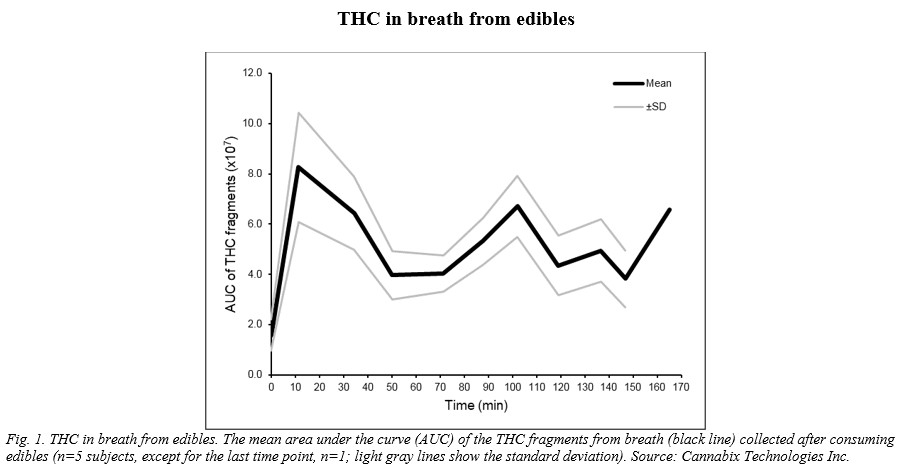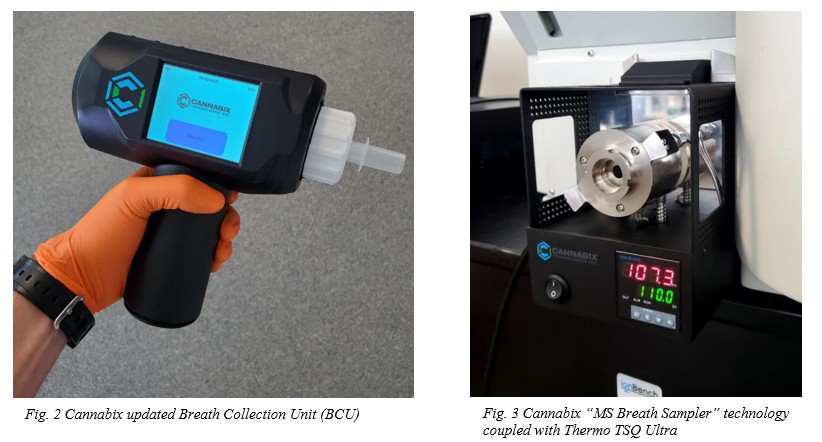News Releases
Cannabix’s MSBS Marijuana Breathalyzer Technology Detects THC in Breath after Edibles Consumption
June 14, 2023
Vancouver, British Columbia, June 14, 2023 -- Cannabix Technologies Inc. (CSE: BLO) (OTC PINK: BLOZF) (the “Company or Cannabix”) developer of marijuana breathalyzer devices for law enforcement and the workplace reports that it’s proprietary laboratory-based marijuana detection equipment (as described below) has detected THC (∆9-tetrahydrocannabinol) in breath samples after consumption of edibles. Cannabix’s Mass Spectrometer Breath Sampler (“MSBS”) technology along with the handheld Breath Collection Unit (“BCU”) have been providing consistent results in the detection of THC in breath from smoking. More recently, the technology has been used to detect THC after consumption of edibles containing marijuana. Cannabix has been focused on developing it MSBS as a new, simpler and effective way to test for recent use of marijuana and confirm for THC in breath using gold-standard mass spectrometry (MS).
Highlights and Updates:
- MSBS technology has shown the sensitivity in the low picogram range, for THC in breath allowing for detection of THC from smoking and edibles up to 4 hours after consumption.
- Cannabix’s MSBS method for detection of THC in breath has striking differences with conventional, legacy methods [1].
- Cannabix has initiated discussions with industry leading forensic laboratory organizations on how to best integrate its novel MSBS hardware into current forensic testing and analysis methods.
- Scientists at Cannabix are experimenting with a ‘quantification marker’ (using deuterated ∆9-THC as an internal standard) added to its breath sample cartridge for confirmation and potential quantification of THC in breath.
- Cannabix has recently delivered its BCU to the Friedel Clinic in Montana for testing with subjects.
THC detection after edibles consumption
Cannabis and its extracted active ingredients are commonly mixed into various types of food, including brownies, cookies, and candy. After eating an edible containing marijuana, THC is absorbed into the bloodstream through the digestive tract and undergoes a first metabolic pass in the liver before entering general circulation. Metabolism through the liver further reduces the amount of analyte that makes its way through to the breath relative to smoking. Figure 1 presents the “THC in breath from edibles” up to 165 minutes after consumption (averaging breath results from 5 subjects) using the Cannabix BCU collection and MSBS analysis method (data at T=0min is collected before consumption). The edibles (gummies and capsules) consumed by various subjects contained a low of 10mg and a high of up to 600mg of infused THC.

MSBS compared to legacy LCMS methods
The MSBS is a novel method for efficient collection of analytes of low volatility from human breath utilizing liquid secondary adsorption. The concept has successfully demonstrated efficient capturing and releasing of THC. This novel method uses the breath aerosol as a carrier of solid and viscous liquid particle analytes as well as a secondary adsorbent to prevent sample loss from droplet surface contact and deposition. Cannabix scientists observe that the collection efficiency of MSBS sampling method is thus far providing superior results relative to conventional LCMS forensic methods. Using the Cannabix method the results for a breath sample can be acquired from start to finish within a few minutes without any sample preparation or preconcentration steps. In comparison, legacy methods require up to 15 minutes of solvent extraction, 150 min of preconcentration, and chromatography which also takes hours. Furthermore, the acquired sample volume is smaller using Cannabix hardware: five breaths compared to 10+ breaths using legacy methods, which is easier and more convenient (and achievable) for subjects [1].
MSBS Technology and BCU
The Company’s handheld Breath Collection Unit (“BCU”, Figure. 2) and mass spectrometer coupled laboratory “MS Breath Sampler” (Figure. 3) are being used together to provide a new method for drug detection that complements gold-standard mass spectrometry (MS) and significantly simplifies laboratory analysis methods, reduces sample turnaround times (thus minimizing operating costs), while maintaining sensitive, precise results.

- Jeerage KM, Beuning CN, Friss AJ, Bidwell LC, Lovestead TM. THC in breath aerosols collected with an impaction filter device before and after legal-market product inhalation-a pilot study. J Breath Res. 2023 May 22;17(3):037103. doi: 10.1088/1752-7163/acd410.
Disclaimer:
The information in these press releases is historical in nature, has not been updated, and is current only to the date indicated in the particular press release. This information may no longer be accurate and therefore you should not rely on the information contained in these press releases. To the extent permitted by law, Cannabix Technologies Inc. and its employees, agents and consultants exclude all liability for any loss or damage arising from the use of, or reliance on, any such information, whether or not caused by any negligent act or omission.

